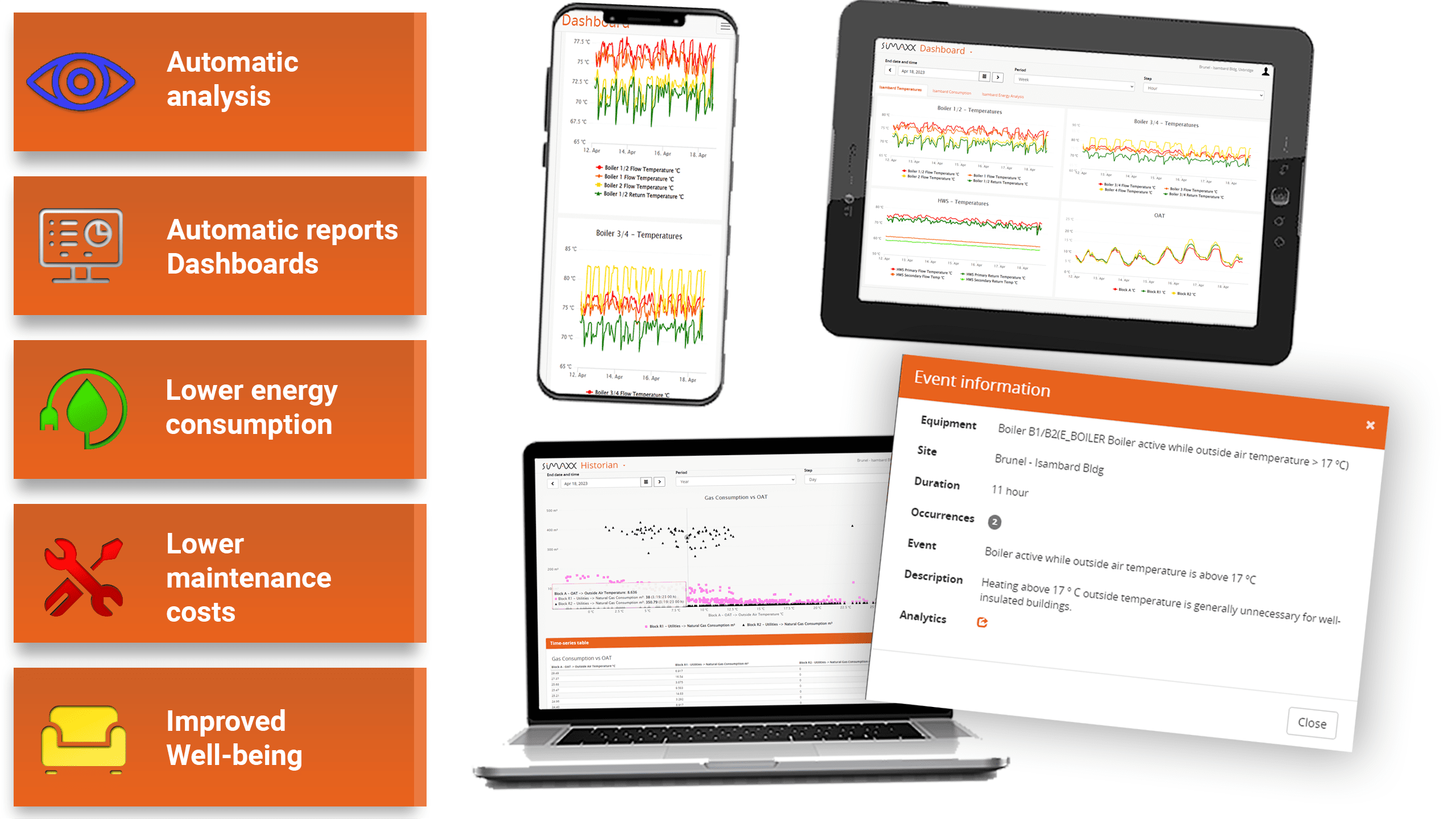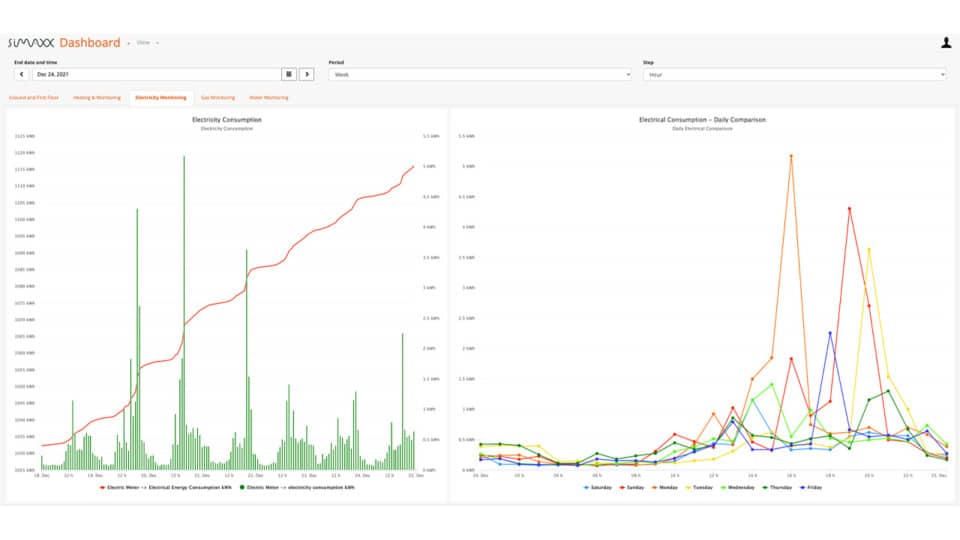Introduction
This document aims to highlight current challenges in the Social Housing segment and how current smart technologies and property management technology trends can be used to address some of these challenges. The document also highlights how the Simaxx Analytics platform is utilising the latest technology to provide the necessary insights to help address these challenges.
CHALLENGES IN SOCIAL HOUSING
(National Housing Federation, 2022)
- 1. CLIMATE AND SUSTAINABILITY
The UK has set in law a target to bring all greenhouse gas emissions to net-zero by 2050. To achieve this, housing associations need to work in partnership with the government to insulate many of their homes and replace fossil fuel heating systems with ‘clean heat’ technologies such as heat pumps and heat networks. Decarbonising Britain’s homes is not only an essential part of tackling the climate emergency, but it also combats fuel poverty, supercharges the economy, creates jobs, and creates warmer homes and cleaner air.
2. ENERGY EFFICIENCY
With large and distributed building portfolios, it can be difficult to identify how and where reductions can be made in energy consumption and carbon emissions. Smart meters, that capture Utility data, can be paired with cloud-based analytic platforms to provide profile alerts, monitor consumption, target anomalies, and reduce environmental impact.
3. OPERATIONAL CHALLENGES
Continued pressure on organisations to achieve more on planned and remedial maintenance with the same or less staff need smart solutions to maximise the efficiencies of available resources. Landlords and Social Housing organisations have an obligation to provide safe living space with respect to critical services. In the light of the recent Covid-19 pandemic, the internal environmental conditions also contribute to a tenant’s overall satisfaction.
BUILDING TECHNOLOGY TRENDS
1. PREDICTIVE MAINTENANCE
Makes use of IoT sensors and other hardware devices to get a report on the state of a commercial building and all the equipment in it. These kinds of innovations tell you exactly when and where maintenance should be provided (IT Trends, 2018).
2. AIR QUALITY MEASUREMENT
One major trend is how smart building air quality can have an impact on the productivity of tenants. IoT devices can be used to check and measure the air quality as well as the CO2 level (Future proptech, 2018).
3. HEAT CONTROL
The use of thermal imaging will allow managers to check for equipment that is outside of the temperature range. Making issue detection easier and enabling a maintenance timeframe before system disruption occurs. (Facility executive, 2018).
4. IOT FOR BETTER ASSET OPTIMISATION
IoT helps to create asset optimisation. It enables managers to use technological solutions, improving the uptime of building equipment mitigating possible loss of product (Future proptech, 2018).
5. IOT FOR ENERGY EFFICIENCY
The most important impact that IoT has on buildings is energy efficiency. Using data to provide well-founded information helps managers to control their assets better and reduce harmful waste in the environment (Facility executive, 2018)
6. REAL-TIME DATA ACCESSIBILITY
IoT applications allow managers to conduct various experiments to check the result of optimization. It also enables them to use IoT devices in monitoring buildings systems using a single view panel (IT Trends, 2018).
Use cases in Social Housing
Social Housing and Compliance Requirements
The UK devolved parliaments are investing significantly into the use of Smart Technology as part of a strategy to tackle the challenges of climate, sustainability, and net-zero goals within the Social Housing Segment. Programmes such as the Innovative Housing Programme in Wales are well underway. Similar schemes are under review in England and Scotland. (Clean Growth Strategy, Green Deal & Catapult Connected Places). Websites like Housemark.co.uk are a useful repository for collating information about current trends in the segment.
Due to the poor success rate of energy efficiency retrofit works, the Government department for Business, Energy and Industrial Strategy has introduced the PAS 2035 standard.
Section 14 of this standard highlights the requirements for monitoring and evaluation of and Energy Efficiency Measure (EEM) projects, to ‘determine whether the intended outcomes of the retrofit project have been realized, and to identify and learn from any project-specific or systematic problems with the retrofit risk assessment, the dwelling assessment, the retrofit design, the installation of EEMs, or the testing, commissioning, or handover of EEMs’.
Smart Technology, such as the Simaxx Analytics platform, can facilitate the data gathering and assessment process for EEM projects.
Simaxx and the Innovative Housing Programme (IHP)
Simaxx has been working with key stakeholders in the Welsh Government’s Innovative Housing Programme. The Simaxx platform is already being used to monitor the performance of over 300 properties in local regional council social housing stock.
We are working with Technology providers to receive the data from sites using a secure cellular communication platform. The data collected from the site is presented in a simple and consistent dashboard view. Analytics and alerts are then configured to provide insights into the performance of the properties based on Key measurements prioritised by the local council.
The reports and alerts can be tailored to provide effective post-occupancy validation of the installation process.
For further information contact ‘[email protected]’
The Innovative Housing Programme
The Innovative Housing Programme (IHP) aims to create demonstrator schemes to help inform the Welsh Government about the type of social housing it should support financially in the future. The programme has supported innovation in construction techniques, delivery pathways and housing types across all tenures.
Houses that generate their own power and homes built using local supply chains are some of the projects to share in £91m of innovative housing funding during the first three years of the programme. The programme has so far funded 52 capital schemes to deliver over 1,400 new innovative homes.
(Welsh Government Document 2021)
Continuous Analysis
Continuous Analysis provides a constant feed of data. Analytic rules and insights are presented in focused Key Performance measures. This concept underpins the platform and ensures data consistency for the end-users.
Be in control of the key data on a refit project. Audit the performance of your contractors.
Visualisation
Flexible Dashboards and simple report creators allow the data collected to be analysed, evaluated, and presented in a way that provides meaningful data to the property manager.
Organise information to present the data you want.
Energy Monitoring
Analytic rules focused on energy consumption and data normalisation (degree days) enable the targeting of energy data. The insights and evaluations can be used in template reports.
The analysis highlights the inefficient commissioning of systems. Minimise energy waste.
Predictive Maintenance
Alerts to prevent disruptions in the mechanical plant or indications that equipment or energy efficiency measures are not operating as intended. Alert messages indicate likely failure & recommended actions.
What is happening? Why is it happening? Prepare service teams to prevent unnecessary site visits.
Improved Well-Being
Continuous monitoring of Air Quality and Environmental conditions. This data and analysis are key for good occupant satisfaction and to ensure habitation standards are met.
Monitor and report on internal Air Quality. Promote and share improved well-being outcomes.
About Simaxx
Increasing demands are being made on buildings. The impact of the climate in buildings on our well-being and productivity is enormous. A good indoor climate results in fewer complaints and greater occupant satisfaction. Every building has installations that control the indoor climate. Using, simple to deploy, IoT solutions, Simaxx can collect data from buildings.
Simaxx translates the available data into information that can be used to alert maintenance requirements and provide insights into well-being and sustainability. The unique aspect of the platform is the flexibility of connecting to the data sources and the algorithms to convert data into information and a user-friendly interface. Dashboards, reports, and event lists are generated based on these analyses. This clarifies the inner workings of a building. By following the actions from the event lists, malfunctions and complaints can be prevented.
If you want to find out more about how Simaxx can provide the perfect analysis tool for your housing portfolio, please get in touch.
WANT TO KNOW MORE OR GET IN CONTACT?






